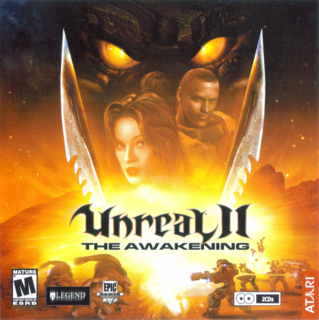Unreal II: The Awakening
So why is it, then, that a game subtitled The Awakening has, on occasion, made me want to take a nap?
Truthfully, Unreal II is not a bad game. I dare say it’s even a good one. But it’s not a great game, and when you rate this sequel in terms of its predecessor, that’s almost like saying it’s a failure. Unreal was unique, envelope-pushing, and magical; Unreal II is safe, derivative, and — while utterly gorgeous — certainly not the mind-bending leap forward in graphics that the first game was.
So, let’s all forget about the Unreal legacy, and judge Unreal II on its own merits. (Easy enough to do, since Unreal II has far more in common with the mission-based feel of Halo, Aliens vs. Predator 2, and Elite Force than it does with the “lone-prisoner-on-a-hostile-world” motif of its forerunner.)
In this one, you play John Dalton, an ex-Marine now earning his corn as a marshal for the Terran Colonial Authority, the force that polices the backwaters of the 24th-century Unreal universe. Your ship is the Atlantis, a creaky old rust-bucket that’s nearly as weathered as your crew: First Officer Aida, the requisite tattooed hot chick; Isaak, the ship’s engineer and tinkerer who provides you with weapon upgrades as the game progresses; and lastly, token alien Ne’ban, the ship’s pilot, whose gelatinous appearance makes him look like a shambling Jello shot.
If this sounds like the setup for some generic syndicated sci-fi TV show…well, it plays like one, too. In fact, the introductory dialogue between you and the commander of the TCA (who sends you out on missions) is so riddled with bad cop-show clichés that I thought somebody had sent me the “joke” review build. But no — much like a space-age T.J. Hooker, Dalton is a tough-but-fair cop with a heart of gold who doesn’t like to play by the rules.
The plot concerns a series of lost artifacts that have been scattered across various exotic alien worlds. The artifacts hold such dangerous, mysterious power that you’re ordered to retrieve them before nastier aliens (like the Skaarj) can get their hands on them. Without giving too much away, the Awakening in the title occurs when the artifacts are joined together…and it’s not a friendly wake-up call, either.
Most of the game’s 12 missions are pretty straightforward. You’re briefed by Aida or your superior, receive a weapons upgrade from Isaak, shuttle down to the planet surface, and shoot any enemy that stands between you and the next artifact. Only a few missions break from this formula, and not surprisingly, they’re among the best.
For example, in one level the Atlantis has to make an unexpected surface landing. Since you’ve just lifted an artifact from under their noses, packs of human mercenaries siege the entrance to your ship, leaving you as its sole defender. There’s even a bit of strategy involved, as your loadout for this particular mission includes force-field generators and turrets, so placing them for maximum benefit is part of the challenge.
Other missions include escort jobs, covering a friendly with a sniper rifle, and even some squad-based action where you’re briefly grouped with Marines. Unfortunately, unlike the organic flow of the first game (oops, there I go again), the mission structure of Unreal II is so transparently intent on introducing you to new play styles and environments in a mechanical fashion — “Look, here’s the acid-rain level…ooh, reflective surfaces…” — that you can almost see the nuts and bolts sticking out from underneath the beautifully bump-mapped visuals.
And perhaps that’s really my biggest beef with Unreal II: it plays like a game-length demo for the graphics engine. While the production values are all first-rate — including terrific voice-acting and sound, and, of course, a graphics engine that really shines when rendering sprawling outdoor environments and weird alien habitats — the razor-thin plot, writing, and overall game design fall flat.
For instance, the onboard soap opera — a secondary story set around the ship’s crew — depends on your caring about their lives, which you don’t. Since they appear only during between-mission down-time aboard the Atlantis (when you can wander the ship aimlessly), and not during the in-game action, you have no Wing Commander–like emotional investment in the characters.
And remember the original Unreal’s first big scare? The lit hallway…lights going out…ka-chunk, ka-chunk, ka-chunk…and then a terrifying Skaarj attack? Well, it’s here again, but this time in an elevator. Now, it’d be fine if this sequence was intended as an homage to the first game — but it’s the only major scripted event of its kind!
One last frustration is due to the lack of a multiplayer mode. Yes, I know…that’s what Unreal Tournament 2003 is for. But Unreal II introduces so many cool new weapons — like the blistering flamethrower, an incendiary alt-fire on the shotgun, and seeker orbs — that you feel cheated not getting to play with them against others online. Mix that with the game’s limited replay value, and not even the pretty visuals can make Unreal II a must-recommend title.

